Jan Peters
Differentiable Physics Models for Real-world Offline Model-based Reinforcement Learning
Nov 03, 2020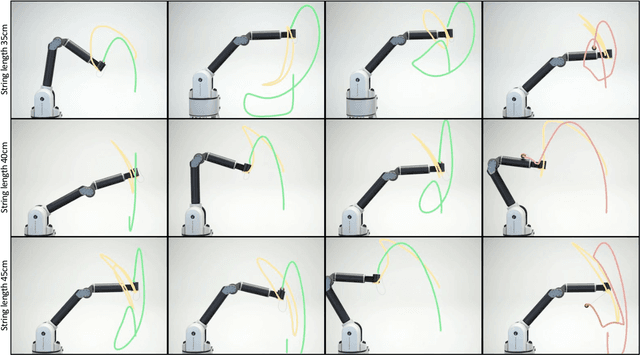
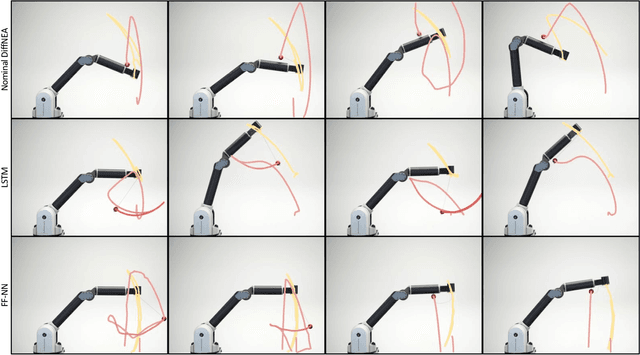

Abstract:A limitation of model-based reinforcement learning (MBRL) is the exploitation of errors in the learned models. Black-box models can fit complex dynamics with high fidelity, but their behavior is undefined outside of the data distribution.Physics-based models are better at extrapolating, due to the general validity of their informed structure, but underfit in the real world due to the presence of unmodeled phenomena. In this work, we demonstrate experimentally that for the offline model-based reinforcement learning setting, physics-based models can be beneficial compared to high-capacity function approximators if the mechanical structure is known. Physics-based models can learn to perform the ball in a cup (BiC) task on a physical manipulator using only 4 minutes of sampled data using offline MBRL. We find that black-box models consistently produce unviable policies for BiC as all predicted trajectories diverge to physically impossible state, despite having access to more data than the physics-based model. In addition, we generalize the approach of physics parameter identification from modeling holonomic multi-body systems to systems with nonholonomic dynamics using end-to-end automatic differentiation. Videos: https://sites.google.com/view/ball-in-a-cup-in-4-minutes/
High Acceleration Reinforcement Learning for Real-World Juggling with Binary Rewards
Oct 31, 2020

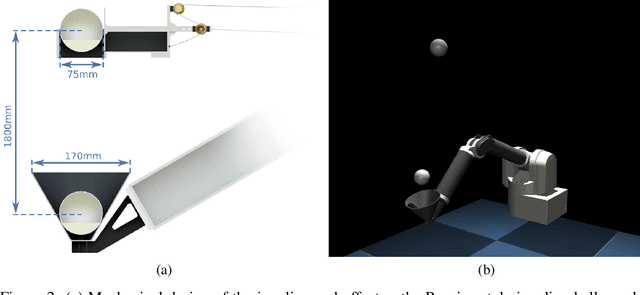

Abstract:Robots that can learn in the physical world will be important to en-able robots to escape their stiff and pre-programmed movements. For dynamic high-acceleration tasks, such as juggling, learning in the real-world is particularly challenging as one must push the limits of the robot and its actuation without harming the system, amplifying the necessity of sample efficiency and safety for robot learning algorithms. In contrast to prior work which mainly focuses on the learning algorithm, we propose a learning system, that directly incorporates these requirements in the design of the policy representation, initialization, and optimization. We demonstrate that this system enables the high-speed Barrett WAM manipulator to learn juggling two balls from 56 minutes of experience with a binary reward signal. The final policy juggles continuously for up to 33 minutes or about 4500 repeated catches. The videos documenting the learning process and the evaluation can be found at https://sites.google.com/view/jugglingbot
Batch Reinforcement Learning with a Nonparametric Off-Policy Policy Gradient
Oct 29, 2020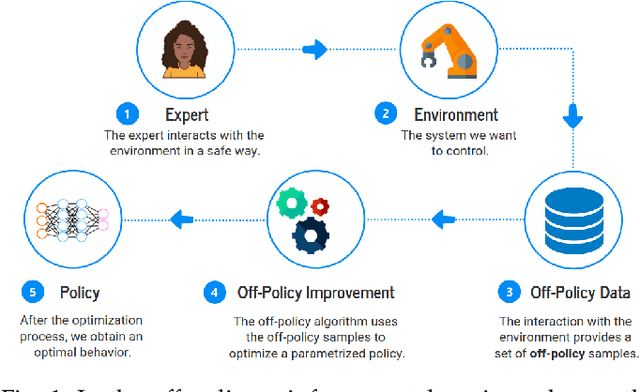
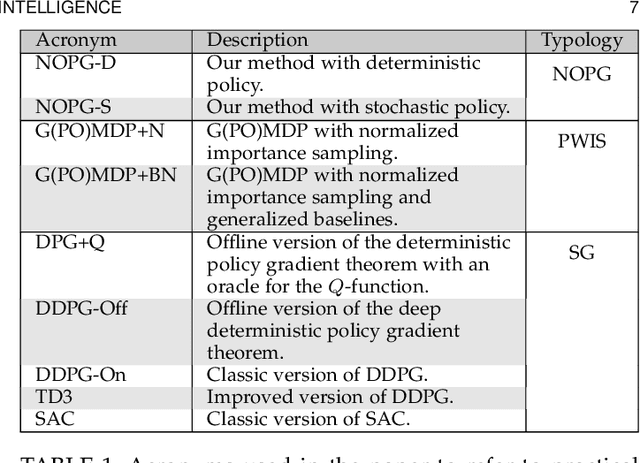
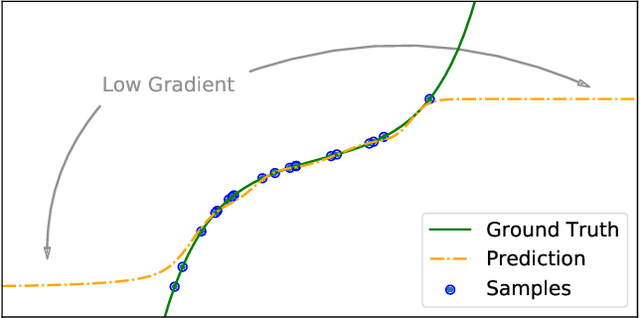

Abstract:Off-policy Reinforcement Learning (RL) holds the promise of better data efficiency as it allows sample reuse and potentially enables safe interaction with the environment. Current off-policy policy gradient methods either suffer from high bias or high variance, delivering often unreliable estimates. The price of inefficiency becomes evident in real-world scenarios such as interaction-driven robot learning, where the success of RL has been rather limited, and a very high sample cost hinders straightforward application. In this paper, we propose a nonparametric Bellman equation, which can be solved in closed form. The solution is differentiable w.r.t the policy parameters and gives access to an estimation of the policy gradient. In this way, we avoid the high variance of importance sampling approaches, and the high bias of semi-gradient methods. We empirically analyze the quality of our gradient estimate against state-of-the-art methods, and show that it outperforms the baselines in terms of sample efficiency on classical control tasks.
Contextual Latent-Movements Off-Policy Optimization for Robotic Manipulation Skills
Oct 26, 2020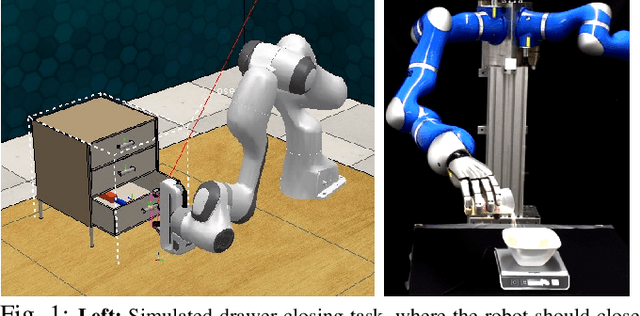
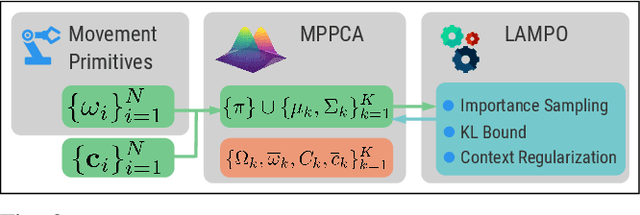
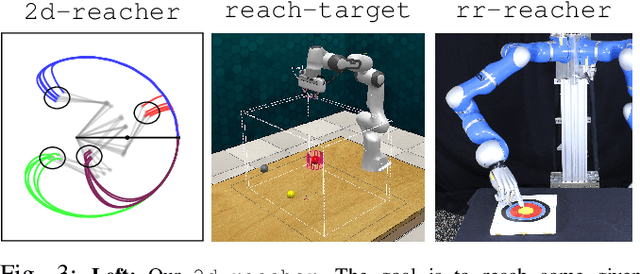
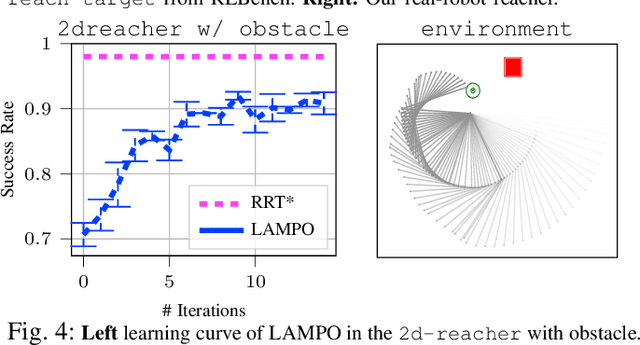
Abstract:Parameterized movement primitives have been extensively used for imitation learning of robotic tasks. However, the high-dimensionality of the parameter space hinders the improvement of such primitives in the reinforcement learning (RL) setting, especially for learning with physical robots. In this paper we propose a novel view on handling the demonstrated trajectories for acquiring low-dimensional, non-linear latent dynamics, using mixtures of probabilistic principal component analyzers (MPPCA) on the movements' parameter space. Moreover, we introduce a new contextual off-policy RL algorithm, named LAtent-Movements Policy Optimization (LAMPO). LAMPO can provide gradient estimates from previous experience using self-normalized importance sampling, hence, making full use of samples collected in previous learning iterations. These advantages combined provide a complete framework for sample-efficient off-policy optimization of movement primitives for robot learning of high-dimensional manipulation skills. Our experimental results conducted both in simulation and on a real robot show that LAMPO provides sample-efficient policies against common approaches in literature.
ImitationFlow: Learning Deep Stable Stochastic Dynamic Systems by Normalizing Flows
Oct 25, 2020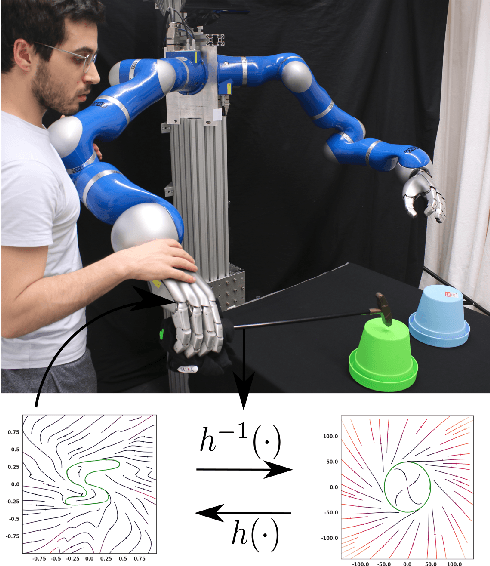
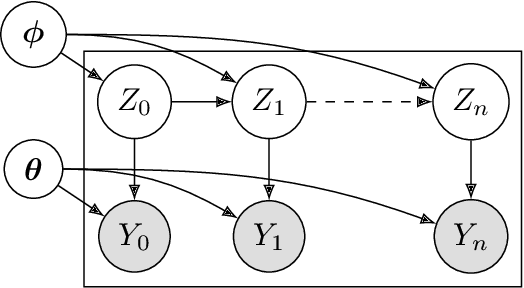

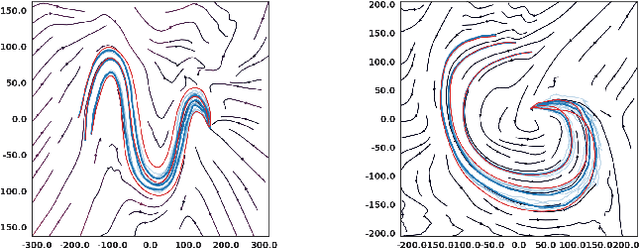
Abstract:We introduce ImitationFlow, a novel Deep generative model that allows learning complex globally stable, stochastic, nonlinear dynamics. Our approach extends the Normalizing Flows framework to learn stable Stochastic Differential Equations. We prove the Lyapunov stability for a class of Stochastic Differential Equations and we propose a learning algorithm to learn them from a set of demonstrated trajectories. Our model extends the set of stable dynamical systems that can be represented by state-of-the-art approaches, eliminates the Gaussian assumption on the demonstrations, and outperforms the previous algorithms in terms of representation accuracy. We show the effectiveness of our method with both standard datasets and a real robot experiment.
A Differentiable Newton Euler Algorithm for Multi-body Model Learning
Oct 19, 2020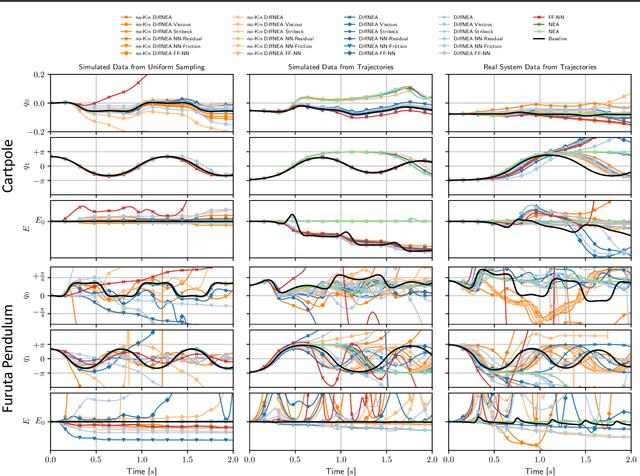
Abstract:In this work, we examine a spectrum of hybrid model for the domain of multi-body robot dynamics. We motivate a computation graph architecture that embodies the Newton Euler equations, emphasizing the utility of the Lie Algebra form in translating the dynamical geometry into an efficient computational structure for learning. We describe the used virtual parameters that enable unconstrained physical plausible dynamics and the used actuator models. In the experiments, we define a family of 26 grey-box models and evaluate them for system identification of the simulated and physical Furuta Pendulum and Cartpole. The comparison shows that the kinematic parameters, required by previous white-box system identification methods, can be accurately inferred from data. Furthermore, we highlight that models with guaranteed bounded energy of the uncontrolled system generate non-divergent trajectories, while more general models have no such guarantee, so their performance strongly depends on the data distribution. Therefore, the main contributions of this work is the introduction of a white-box model that jointly learns dynamic and kinematics parameters and can be combined with black-box components. We then provide extensive empirical evaluation on challenging systems and different datasets that elucidates the comparative performance of our grey-box architecture with comparable white- and black-box models.
Differentiable Implicit Layers
Oct 14, 2020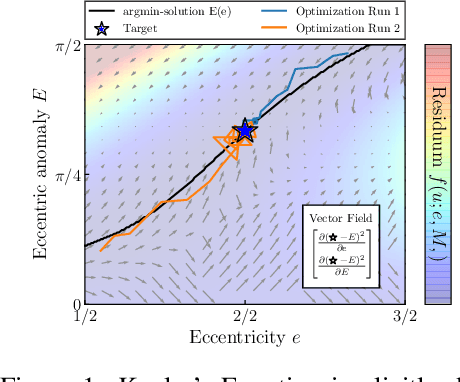



Abstract:In this paper, we introduce an efficient backpropagation scheme for non-constrained implicit functions. These functions are parametrized by a set of learnable weights and may optionally depend on some input; making them perfectly suitable as learnable layer in a neural network. We demonstrate our scheme on different applications: (i) neural ODEs with the implicit Euler method, and (ii) system identification in model predictive control.
Active Inference or Control as Inference? A Unifying View
Oct 01, 2020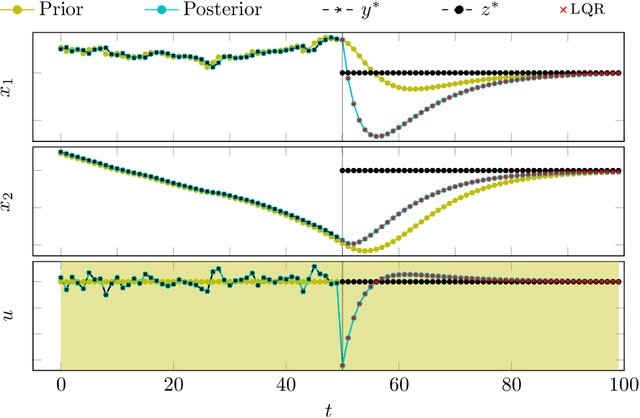
Abstract:Active inference (AI) is a persuasive theoretical framework from computational neuroscience that seeks to describe action and perception as inference-based computation. However, this framework has yet to provide practical sensorimotor control algorithms that are competitive with alternative approaches. In this work, we frame active inference through the lens of control as inference (CaI), a body of work that presents trajectory optimization as inference. From the wider view of `probabilistic numerics', CaI offers principled, numerically robust optimal control solvers that provide uncertainty quantification, and can scale to nonlinear problems with approximate inference. We show that AI may be framed as partially-observed CaI when the cost function is defined specifically in the observation states.
Advances in Human-Robot Handshaking
Aug 26, 2020
Abstract:The use of social, anthropomorphic robots to support humans in various industries has been on the rise. During Human-Robot Interaction (HRI), physically interactive non-verbal behaviour is key for more natural interactions. Handshaking is one such natural interaction used commonly in many social contexts. It is one of the first non-verbal interactions which takes place and should, therefore, be part of the repertoire of a social robot. In this paper, we explore the existing state of Human-Robot Handshaking and discuss possible ways forward for such physically interactive behaviours.
Assisted Teleoperation in Changing Environments with a Mixture of Virtual Guides
Aug 12, 2020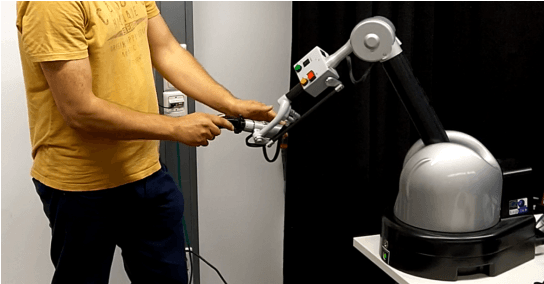
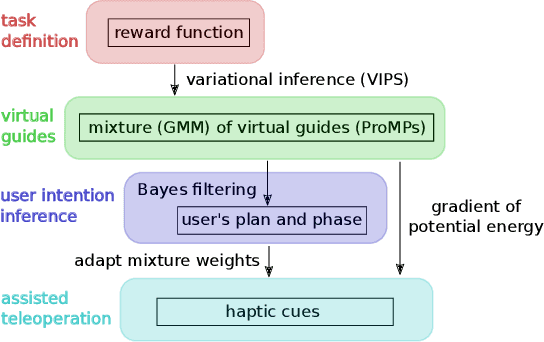
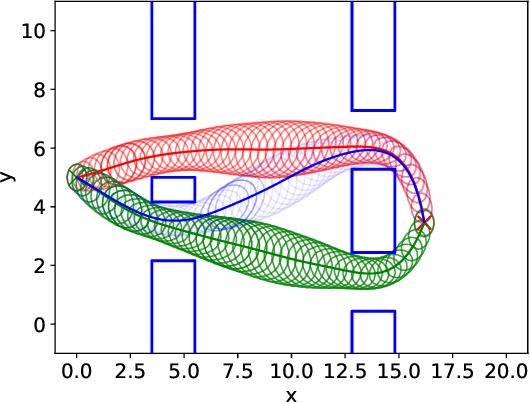
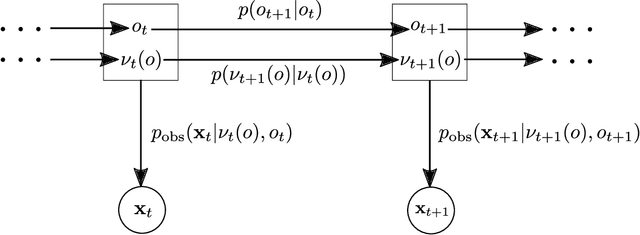
Abstract:Haptic guidance is a powerful technique to combine the strengths of humans and autonomous systems for teleoperation. The autonomous system can provide haptic cues to enable the operator to perform precise movements; the operator can interfere with the plan of the autonomous system leveraging his/her superior cognitive capabilities. However, providing haptic cues such that the individual strengths are not impaired is challenging because low forces provide little guidance, whereas strong forces can hinder the operator in realizing his/her plan. Based on variational inference, we learn a Gaussian mixture model (GMM) over trajectories to accomplish a given task. The learned GMM is used to construct a potential field which determines the haptic cues. The potential field smoothly changes during teleoperation based on our updated belief over the plans and their respective phases. Furthermore, new plans are learned online when the operator does not follow any of the proposed plans, or after changes in the environment. User studies confirm that our framework helps users perform teleoperation tasks more accurately than without haptic cues and, in some cases, faster. Moreover, we demonstrate the use of our framework to help a subject teleoperate a 7 DoF manipulator in a pick-and-place task.
* 19 pages, 9 figures
 Add to Chrome
Add to Chrome Add to Firefox
Add to Firefox Add to Edge
Add to Edge